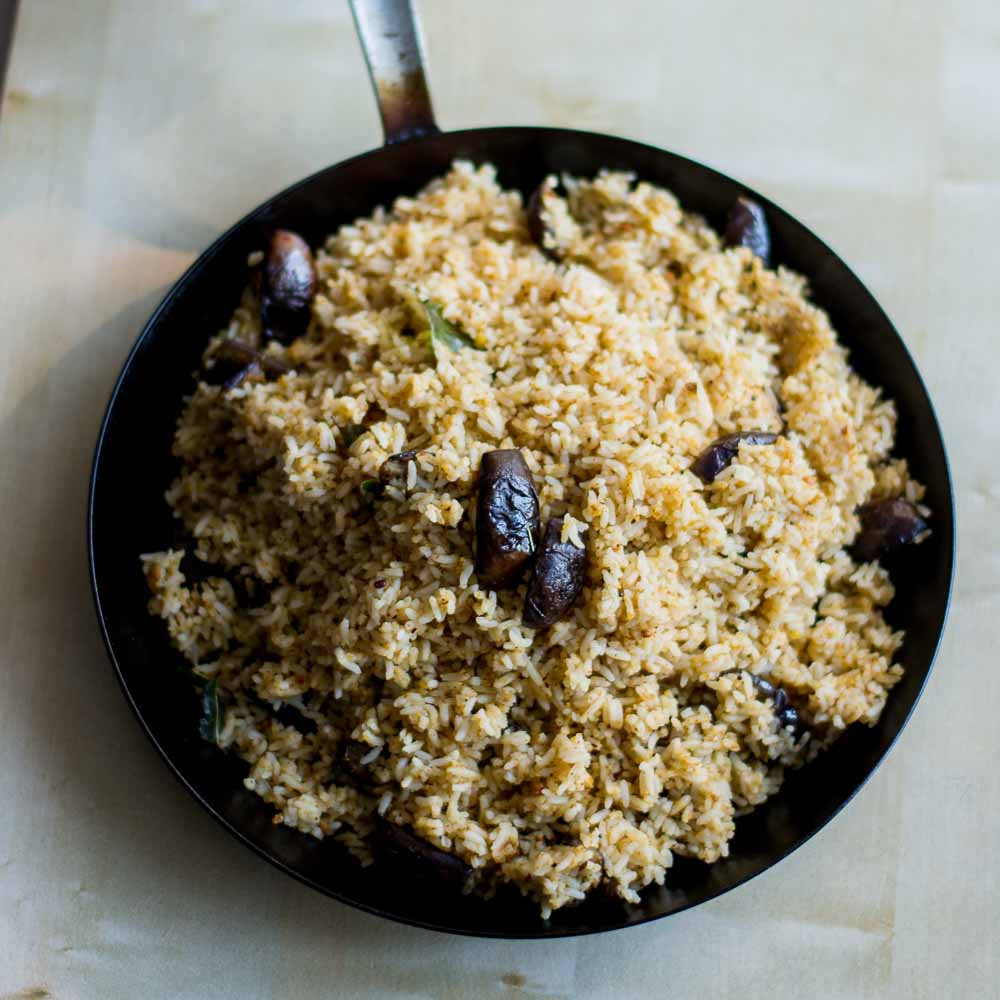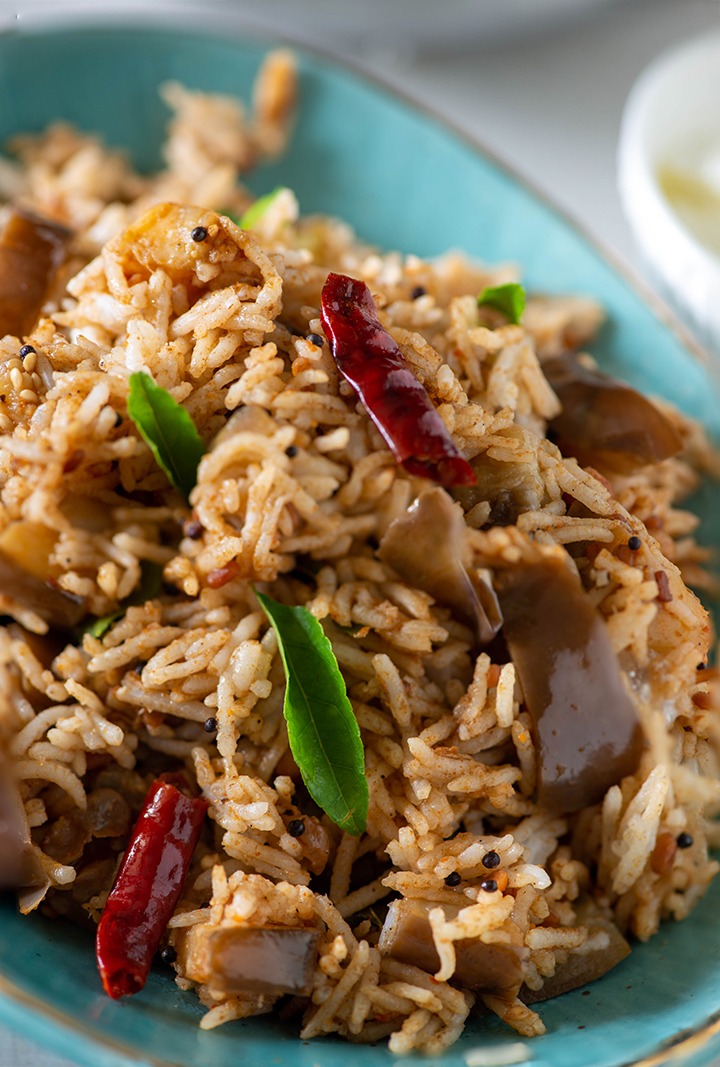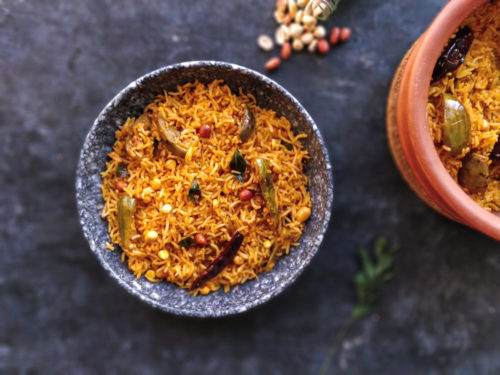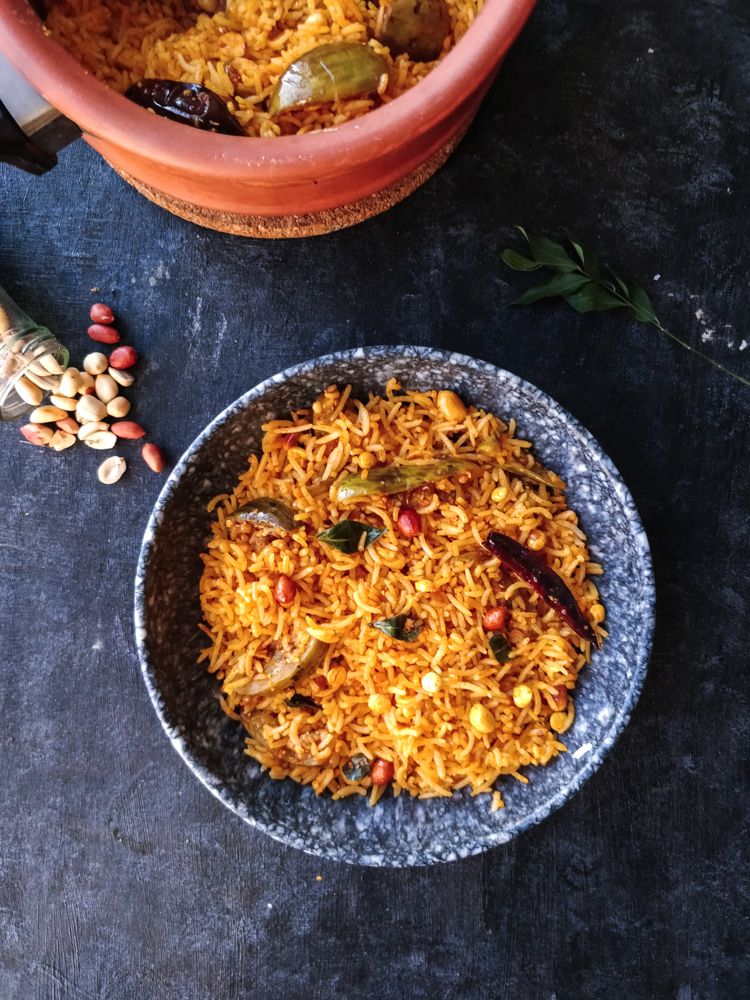Vangi Bath, also known as Brinjal Rice, is a cherished dish from the southern belts of India, particularly enjoyed in the states of Karnataka and Maharashtra. Vangi, meaning ‘brinjal’ or ‘eggplant’ in various local languages, takes center stage in this alluring culinary creation that presents this humble vegetable in a whole new light. The essence of Vangi Bath lies in its blend of soft, roasted eggplants with aromatic spices and fluffy rice, culminating in a harmonious medley of flavors that ensnare the palate.
This dish is crafted by sautéing or roasting brinjals that have been cut into bite-sized pieces, together with an exquisite mix of Vangi Bath masala – a special spice blend which often consists of coriander seeds, cumin, black pepper, dry red chilies, desiccated coconut, chana dal, and urad dal, among other ingredients. The roasted eggplants are then mixed with cooked rice, traditionally seasoned in a similar manner to the Pulihora or Bisi Bele Bath with mustard seeds, curry leaves, and other tempering elements.
Vangi Bath Brinjal Rice Recipe


Vangi Bath Brinjal Rice
Equipment
- 1 large skillet
Ingredients
FOR THE VANGI BATH POWDER
- 4 red chiles preferably byadgi chiles
- 2 whole cloves
- 2 green cardamom pods
- 1 1-inch cinnamon stick
- 1 teaspoon coriander seeds
- 1 teaspoon husked whole black lentils
- 1 teaspoon Bengal gram
- 1/2 teaspoon cumin seeds
- 1/2 teaspoon poppy seeds
- 1/4 teaspoon fenugreek seeds
- 1/4 teaspoon peppercorns
- 2 teaspoons shredded fresh coconut or frozen, thawed to room temperature
FOR THE SPICED EGGPLANT
- 2 tablespoons vegetable or corn oil
- 1 teaspoon mustard seeds
- 1 teaspoon husked whole black lentils
- 1 teaspoon Bengal gram
- 2 curry leaf sprigs
- 1/4 teaspoon asafoetida
- 1/2 cup finely chopped onion
- 2 graffiti eggplants brinjals, cut into 2-inch pieces (about 2 cups)
- 2 teaspoons salt
- 1/4 teaspoon ground turmeric
- 1 tablespoon water
- 1/2 teaspoon powdered jaggery
- 2 tablespoons finely chopped fresh cilantro
- 1 small marble-size seedless tamarind block soaked in 1/2 cup boiling water for 30 minutes
Instructions
TO MAKE THE VANGI BATH POWDER
- Place a large skillet over medium heat.
- Add the chiles, cloves, cardamom, cinnamon, coriander seeds, black lentils, Bengal gram, cumin seeds, poppy seeds, fenugreek seeds, peppercorns, and coconut. Dry-roast for 3 to 4
- minutes until the Bengal gram turns light brown. Turn off the heat and let the spices cool.
- Transfer the spice mixture to a spice grinder or clean coffee grinder and grind into a fine powder. Set aside.
TO MAKE THE SPICED EGGPLANT
- Stir the tamarind and the water it has been soaking in. Using your fingers, remove the tamarind flesh and squeeze the juice from the pods, removing any fibers and membranes. Pour the mixture into a fine-mesh strainer set over a bowl and use a spoon to press as much of the pulp as possible through the strainer. Set the tamarind pulp aside.
- Wipe out the skillet and place it, or a kadai, over medium heat and heat the vegetable oil.
- Add the mustard seeds, black lentils, and Bengal gram. Cook until the mustard seeds begin to sputter, about 1 minute.
- Add the curry leaves and asafoetida and cook for 30 seconds.
- Add the onion and cook for 5 minutes, or until the onion is softand translucent.
- Add the eggplant, salt, turmeric, and water. Stir to combine, cover the skillet, and cook for 1 minute.
- Stir in the jaggery, vangi bath powder, and tamarind pulp. Cook for 5 to 7 minutes until the water is absorbed. Turn off the heat.
- Add the spiced eggplant mixture to the rice and stir until mixed thoroughly.
- Stir in the cilantro.
Notes
Cooking Tips about Vangi Bath Brinjal Rice

- Choosing Eggplants: Select fresh, firm, and small to medium-sized eggplants (brinjals) that have a bright color and smooth skin. They are less likely to be bitter and become tender more evenly when cooked.
- Prepping Eggplants: To keep the diced eggplants from browning and to remove any potential bitterness, soak them in saltwater after cutting. Be sure to drain them well before cooking to avoid water logging the dish.
- Roasting the Eggplants: Pan roasting the eggplants with a little oil until they are golden brown on all sides will give them a slightly smoky flavor and ensure they are fully cooked before mixing them with rice.
- Vangi Bath Masala: The distinct taste of Vangi Bath comes from its special spice blend. You can either make your own masala by roasting and grinding spices like coriander seeds, dried red chilies, cumin, cinnamon, cloves, cardamom, fenugreek seeds, and desiccated coconut, or you can use a store-bought Vangi Bath powder for convenience.
- Basmati or Sona Masuri Rice: Basmati rice gives a fragrant and elegant touch to Vangi Bath, but if you want a more authentic South Indian flavor, go for Sona Masuri rice. Cook the rice to be fluffy and non-sticky, as it should mix well with the spice blend and eggplants without becoming mushy.
- Tempering (Tadka): A proper tempering is crucial for flavor. Use a generous amount of oil or ghee and sauté mustard seeds, curry leaves, urad dal, asafetida (hing), and possibly some cashews until they splutter and take on a golden hue.
- Balancing Flavors: Ensure there’s a balance between the nutty masala, tanginess (some recipes call for tamarind pulp), sweetness (a pinch of sugar or jaggery can be added), heat (adjust chili according to your preference), and the bitterness (from the eggplants).
- Cooking Time: Cook the rice and eggplants separately, then mix them with the masala towards the end. This prevents overcooking and maintains the integrity of each ingredient.
Serving suggestions about Vangi Bath Brinjal Rice

- Raita: A chilled cucumber or onion raita can complement the warm spices of Vangi Bath, providing a refreshing contrast.
- Papad: Crisp papads (lentil wafers) are the perfect accompaniment for adding a crunchy texture to the meal.
- Salad: Serve with a simple salad of raw onions, tomatoes, cucumbers, and carrots, which can cleanse the palate and provide a fresh crunch.
- Pickle: A spoonful of tangy Indian pickle will intensify the flavors with its spicy kick.
- Plain Yogurt: If raita isn’t available, plain yogurt can also serve as a cool and soothing side to balance the spice-forward nature of the dish.
- Chips or Crisps: Ted potato chips or crispy banana chips can add a salty, crunchy texture that contrasts well with the softness of the rice and eggplants.
- Fried or Roasted Vegetables: Other vegetables such as bell peppers, cauliflower, or potatoes either fried or roasted, can be served as a side dish to add variety in taste and texture.
- Lemon Wedges: The addition of a few lemon wedges allows guests to adjust the acidity of their meal to their liking.
Top 5 FAQs about Vangi Bath Brinjal Rice

- What kind of eggplants are best for Vangi Bath? Small to medium-sized eggplants, which are firm with a smooth skin, are ideal for Vangi Bath. These eggplants tend to have fewer seeds and are less bitter, cooking evenly and absorbing the masala well.
- Can I use store-bought Vangi Bath masala powder? Yes, you can use a high-quality store-bought Vangi Bath masala powder for convenience. However, making the masala at home by roasting and grinding spices like coriander seeds, cumin, dry red chilies, fenugreek seeds, cinnamon, cloves, cardamom, and desiccated coconut may enhance the flavor of the dish.
- How can I prevent eggplants from turning brown after cutting them? To prevent eggplants from oxidizing and turning brown, place the cut pieces in a bowl of water with some salt added. Just make sure to drain them properly and pat dry before sautéing to remove excess moisture.
- What type of rice should I use for making Vangi Bath? Sona Masuri or Basmati rice are commonly used for Vangi Bath. The rice grains should be cooked so that they remain separate and non-sticky since they need to be mixed evenly with the roasted eggplants and masala.
- Are there any special tips for making the perfect Vangi Bath? Here are a few tips for delicious Vangi Bath:
- Roast the eggplants until they are nicely browned to add a smoky flavor.
- Add the Vangi Bath masala towards the end of cooking the eggplants to preserve the freshness of the spices.
- Balance the tanginess of the dish by using tamarind pulp effectively.
- Let the dish rest for 10-15 minutes before serving to allow the flavors to meld together.
- Garnish with fresh cilantro and serve with a side of raita or salad for a complete meal.

Leave a Reply